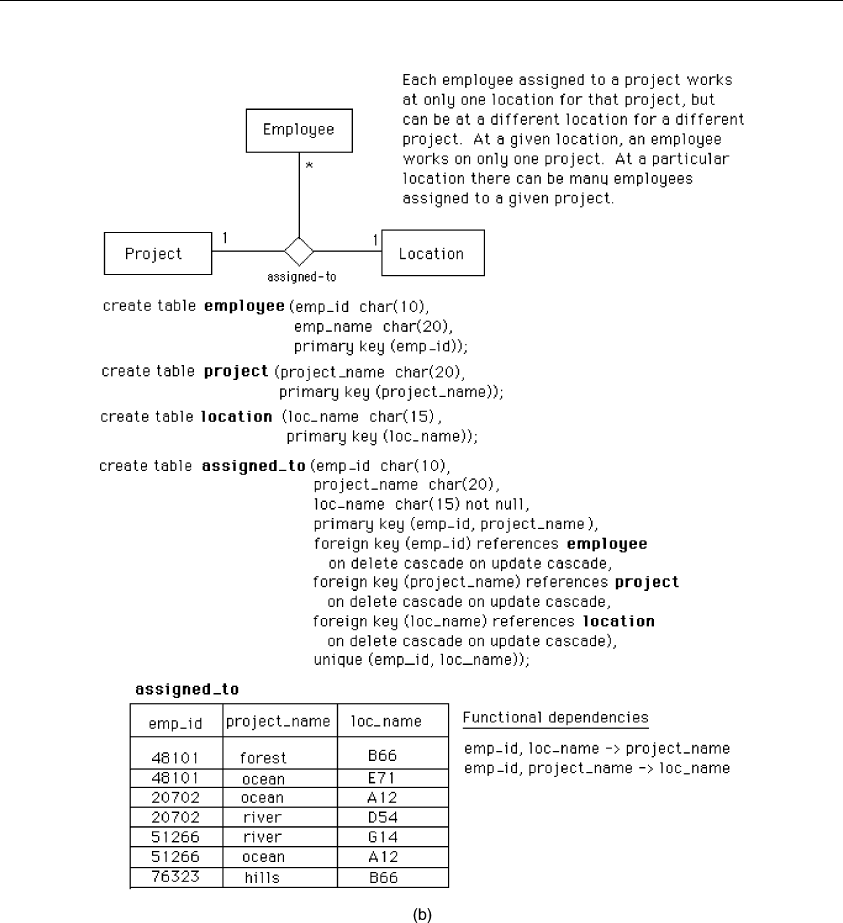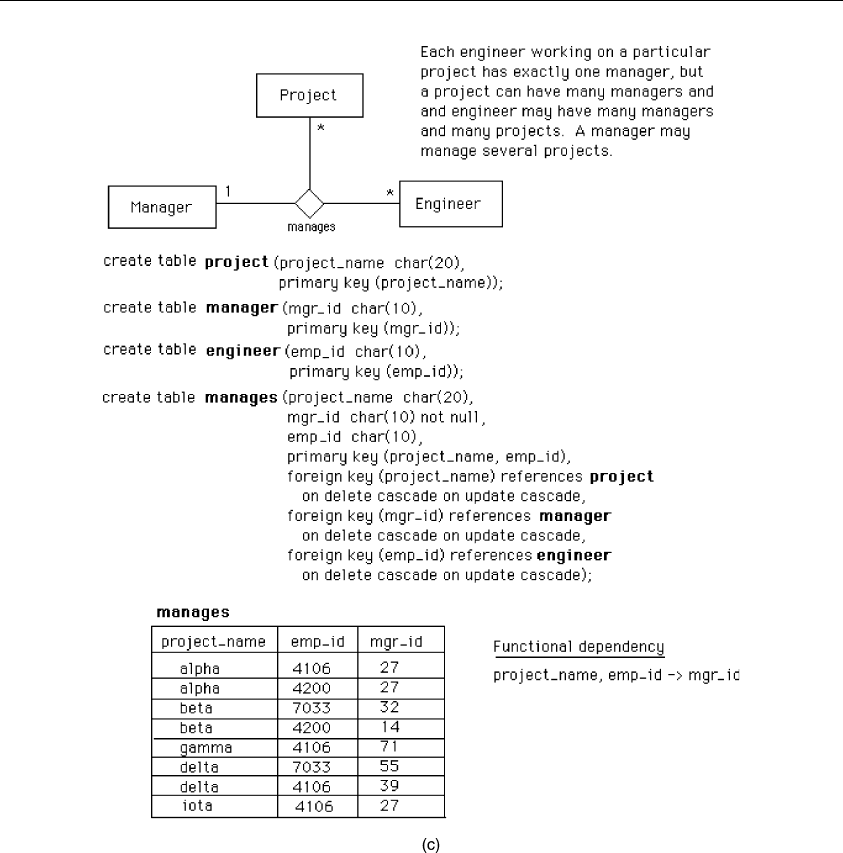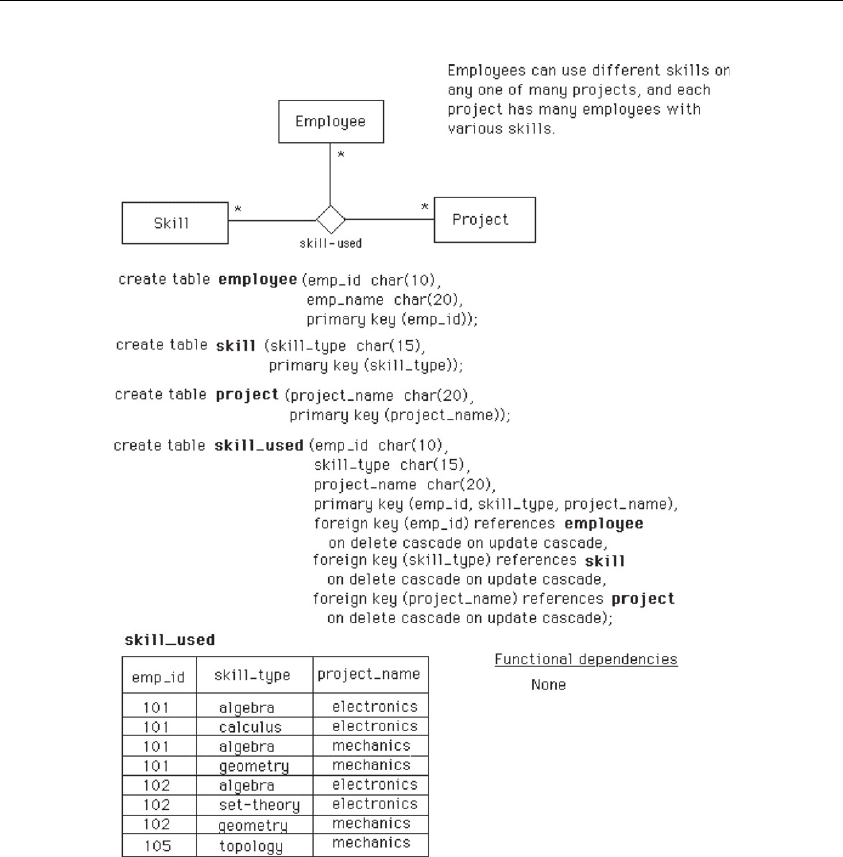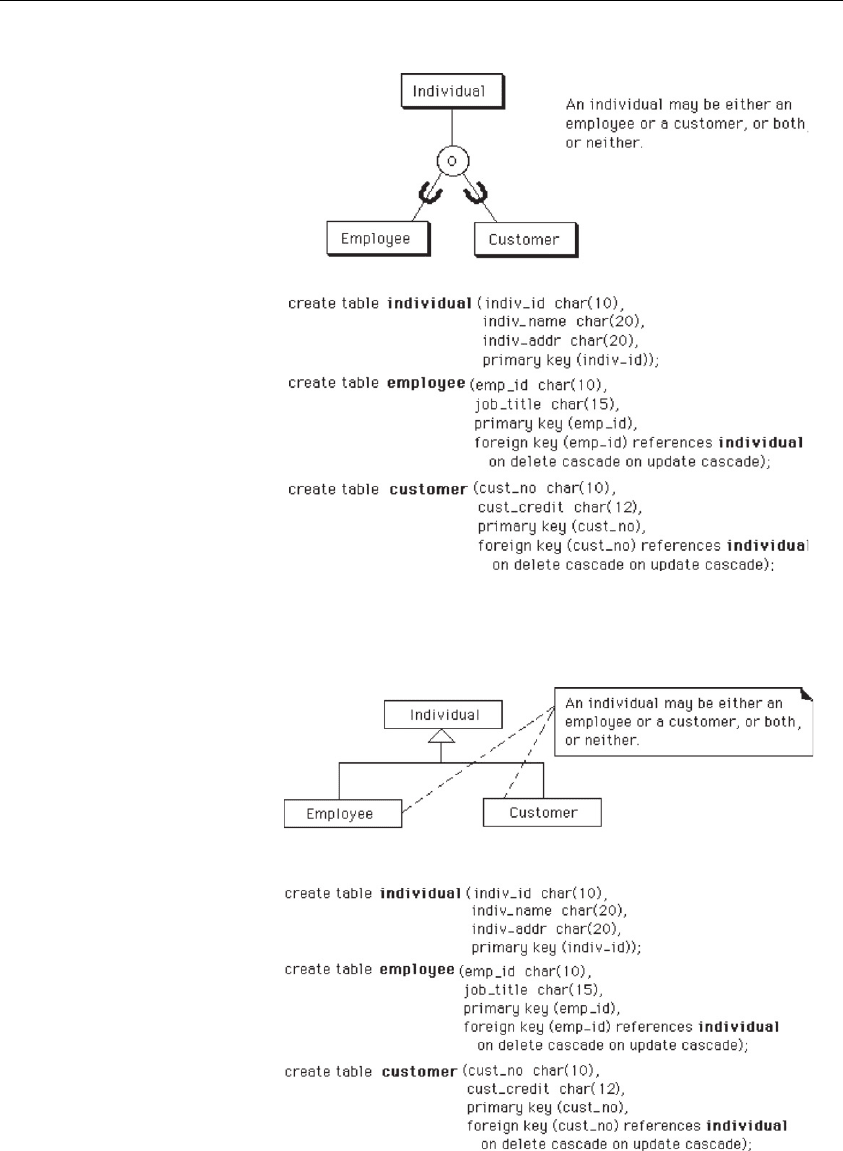Teorey J., Lightstone S., Nadeau T. Database Modeling and Design: Logical Design
Подождите немного. Документ загружается.


Transformation Steps
The following list summarizes the basic transformation
steps from an ER diagram to SQL tables:
• Transform each entity into a table containing the key
and nonkey attributes of the entity.
Figure 5.6, cont’d (b) one-to-one-to-many,
Continued
Chapter 5 TRANSFORMING THE CONCEPTUAL DATA MODEL TO SQL 101

• Transform every many-to-many binary or binary recur-
sive relationship into a table with the keys of the entities
and the attributes of the relationship.
• Transform every ternary or higher-level n-ary relation-
ship into a table.
Now let us study each step in turn.
Figure 5.6, cont’d (c) one-to-many-to-many, and
102 Chapter 5 TRANSFORMING THE CONCEPTUAL DATA MODEL TO SQL

Entity Transformation
If there is a one-to-many relationship between two
entities, add the key of the entity on the “one” side (the
parent) into the child table as a foreign key. If there is a
one-to-one relationship between one entity and another
entity, add the key of one of the entities into the table for
(d)
Figure 5.6, cont’d (d) many-to-many-to-many ternary relationships.
Chapter 5 TRANSFORMING THE CONCEPTUAL DATA MODEL TO SQL 103

Figure 5.7 ER model:
generalization and
aggregation.
Figure 5.8 UML:
generalization and
aggregation.
104 Chapter 5 TRANSFORMING THE CONCEPTUAL DATA MODEL TO SQL

the other entity, thus changing it to a foreign key. The addi-
tion of a foreign key due to a one-to-one relationship can
be made in either direction. One strategy is to maintain
the most natural parent–child relationship by putting the
parent key into the child table. Another strategy is based
on efficiency: Add the foreign key to the table with fewer
rows.
Every entity in a generalization hierarchy is transformed
into a table. Each of these tables contains the key of the
supertype entity; in reality, the subtype primary keys are
foreign keys as well. The supertype table also contains
nonkey values that are common to all the relevant entities;
the other tables contain nonkey values specific to each
subtype entity.
SQL constructs for these transformations may include
constraints for not null, unique, and foreign key. A primary
key must be specified for each table, either explicitly from
among the keys in the ER diagram or by taking the com-
posite of all attributes as the default key. Note that the pri-
mary key designation implies that the attribute is not null
and unique. It is important to note, however, that not all
DBMSs follow the ANSI standard in this regard—it may
be possible in some systems to create a primary key that
can be null. We recommend that you specify “not null”
explicitly for all key attributes.
Many-to-Many Binary Relationship
Transformation
In this step, every many-to-many binary relationship is
transformed into a table containing the keys of the entities
and the attributes of the relationship. The resulting table
will show the correspondence between specific instances
of one entity and those of another entity. Any attribute of
this correspondence, such as the elected office an engineer
has in a professional association (Figure 5.1f), is consid-
ered
intersection data and is added to the table as a non-
key attribute.
SQL constructs for this transformation may include
constraints
for not null.
The unique constraint is not used
here because all keys are composites of the participating
primary keys of the associated entities in the relationship.
Chapter 5 TRANSFORMING THE CONCEPTUAL DATA MODEL TO SQL 105

The constraints for primary key and foreign key are
required, because a table is defined as containing a com-
posite of the primary keys of the associated entities.
Ternary Relationship Transformation
In this step, every ternary (or higher n-ary) relationship
is transformed into a table. Ternary or higher n-ary
relationships are defined as a collection of the n primary
keys in the associated entities in that relationship, with
possibly some nonkey attributes that are dependent on
the key formed by the composite of those n primary keys.
SQL constructs for this transformation must include
constraints for not null, since optionality is not allowed.
The unique constraint is not used for individual attributes,
because all keys are composites of the participating pri-
mary keys of the associated entities in the relationship.
The constraints for primary key and foreign key are
required because a table is defined as a composite of the
primary keys of the associated entities. The unique clause
must also be used to define alternate keys that often occur
with ternary relationships. Note that a table derived from
an n-ary relationship has n foreign keys.
Example of ER-to-SQL Transformation
ER diagrams for the company personnel and project data-
base (see Chapter 4) can be transformed to SQL tables. A
summary of the transformation of entities and relationships
to SQL tables is illustrated in the following lists.
SQL tables derived directly from entities (see Figure 4.3d):
division
department
employee
manager
secretary
engineer
technician
skill
project
location
prof_assoc
106 Chapter 5 TRANSFORMING THE CONCEPTUAL DATA MODEL TO SQL

desktop
SQL tables derived from many-to-many binary or many-
to-many binary recursive relationships:
belongs_to
SQL tables transformed from ternary relationships:
skill_used
assigned_to
Summary
Entities, attributes, and relationships in the ER model
and classes, attributes, and associations in UML can be
transformed directly into SQL table definitions with some
simple rules. Entities are transformed into tables, with
all attributes mapped one-to-one to table attributes.
Tables representing entities that are the child (“many” side)
of a parent–child (one-to-many or one-to-one) relationship
must also include, as a foreign key, the primary key of the
parent entity. A many-to-many relationship is transformed
into a table that contains the primary keys of the associated
entities as its composite primary key; the components of
that key are also designated as foreign keys in SQL. A ternary
or higher-level n -ary relationship is transformed into a table
that contains the primary keys of the associated entities;
these keys are designated as foreign keys in SQL. A subset
of those keys can be designated as the primary key,
depending on the functional dependencies associated with
the relationship. Rules for generalization require the inheri-
tance of the primary key from the supertype to the subtype
entities when transformed into SQL tables. Optionality con-
straints in the ER or UML diagrams translate into nulls
allowed in the relational model when applied to the “one”
side of a relationship. In SQL, the lack of an optionality con-
straint determines the not null designation in the create
table definition.
Chapter 5 TRANSFORMING THE CONCEPTUAL DATA MODEL TO SQL 107

Tips and Insights for Database
Professionals
Tip 1. Use software (CASE) tools when possible (e.g.,
ERwin). These transformations are fairly mechanical in
nature.
Tip 2. Entities become tables.
Tip 3. Simple attributes become data items in tables.
Tip 4. Complex attributes—consider redefining as
entities (tables) with foreign keys back to the parent
entity (its primary key).
Tip 5. One-to-one or one-to-many relationships must
be connected by primary key/foreign key pairs
between tables.
Tip 6. Many-to-many relationships become an “inter-
connect” table that simulates two equivalent one-to-
many relationships.
Tip 7. n-ary relationships becomes an “interconnect”
table with primary key/foreign key pairs to simulate
actual relationships among attributes.
Tip 8. Generalization defines a table for the supertype
entity and all subtype entities. Analyze carefully before
creating extra tables; ask, “Are they really needed?”; if so,
then maintain the primary key/foreign key connection.
Tip 9. Analyze the SQL tables you defined to deter-
mine which data is redundant, and also where there
is insufficient data to answer typical queries stated in
the requirements specifications. Make adjustments as
needed to avoid these problems.
Literature Summary
Definition of the basic transformations from the ER
model to tables is covered in McGee (1974), Wong and Katz
(1979), Sakai (1983), Martin (1983), Hawryszkiewyck
(1984), Jajodia and Ng (1984), and for UML in Muller
(1999).
108 Chapter 5 TRANSFORMING THE CONCEPTUAL DATA MODEL TO SQL

6
NORMALIZATION
CHAPTER OUTLINE
Fundamentals of Normalization 110
First Normal Form 111
Superkeys, Candidate Keys, and Primary Keys 112
Second Normal Form 113
Third Normal Form 116
Boyce-Codd Normal Form 117
The Design of Normalized Tables: A Simple Example 118
Normalization of Candidate Tables Derived from ER
Diagrams 120
Determining the Minimum Set of 3NF Tables 124
Inference Rules (Armstrong Axioms) 124
Summary 128
Tips and Insights for Database Professionals 129
Literature Summary 130
This chapter focuses on the fundamentals of normal
forms
for relational databases and
the database design
step that normalizes the candidate tables (Step II.d of the
database design life cycle). It also investigates the equiva-
lence between the conceptual data model (e.g., the
entity–relationship (ER) model) and normal forms for
tables. As we go through the examples in this chapter it
should become obvious that good, thoughtful design of a
conceptual model will result in databases that are either
already normalized or can be easily normalized with minor
changes. This illustrates the beauty of the conceptual
modeling approach to database design, in that the experi-
enced relational database designer will develop a natural
gravitation toward a normalized model from the beginning.
109

For most database practitioners, the first three sections
of this chapter cover the critical normalization needed for
everyday use, through Boyce-Codd Normal Form (BCNF).
The final section describes an algorithm for finding the
minimum set of third normal form (3NF) tables when the
initial design of tables becomes large and unwieldy.
Fundamentals of Normalization
Relational database tables, whether they are derived
from ER or Unified Modeling Language (UML) models,
sometimes suffer from some rather serious problems in
terms of performance, integrity, and maintainability. For
example, when the entire database is defined as a single
large table, it can result in a large amount of redundant
data and lengthy searches for just a small number of target
rows. It can also result in long and expensive updates, and
deletions in particular can result in the elimination of use-
ful data as an unwanted side effect.
Such a situation is shown in Figure 6.1, where products,
salespersons, customers, and orders are all stored in a sin-
gle table called Sales. In this table we see that certain prod-
uct and customer information is stored redundantly,
wasting storage space. Certain queries, such as “Which
customers ordered vacuum cleaners last month?,” would
require a search of the entire table. Also, updates, such as
changing the address of the customer Dave Bachmann,
Sales
product-name
vacuum cleaner
computer
refrigerator
DVD player
radio
CD player
vacuum cleaner
vacuum cleaner
refrigerator
television
1458
2730
2460
519
1986
1817
1865
1885
1943
2315
Dave Bachmann
Qiang Zhu
Mike Stolarchuck
Peter Honeyman
Charles Antonelli
C.V. Ravishankar
Charles Antonelli
Betsy Karmeisool
Dave Bachmann
Sakti Pramanik
Austin
Plymouth
Ann Arbor
Detroit
Chicago
Mumbai
Chicago
Detroit
Austin
East lansing
6
10
8
3
7
8
7
8
6
6
1-3-03
4-15-05
9-12-04
12-5-04
5-10-05
8-3-02
10-1-04
4-19-99
1-4-04
3-15-04
Carl Bloch
Ted Hanss
Dick Phillips
Fred Remley
R. Metz
Paul Basile
Carl Bloch
Carl Bloch
Dick Phillips
Fred Remley
order-no cust-name cust-addr credit date sales-name
Figure 6.1 Single table
database.
110 Chapter 6 NORMALIZATION
